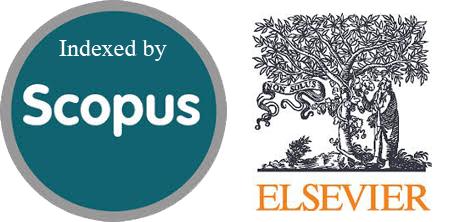بكتيريا مقاومة لمضادات الميكروبات في مرضى الحروق: دور تكوين البيوفيلم
DOI:
https://doi.org/10.54133/ajms.v5i.263الكلمات المفتاحية:
Biofilm، Burns، Emerging threats، Multidrug resistant bacteriaالملخص
الخلفية: تمثل الأغشية الحيوية مشكلة خطيرة وهي مسؤولة إلى حد كبير عن الوفاة الناجمة عن الحروق، وتهدد البكتيريا المقاومة للمضادات الحيوية الصحة العامة العالمية بسبب ارتفاع معدلات الإصابة بمسببات الأمراض. الأهداف: الهدف من الدراسة هو دراسة معدل التهديدات الناشئة لدى مرضى الحروق المتمثلة في عزل البكتيريا المقاومة للمضادات الحيوية المتعددة ودور تكوين الأغشية الحيوية في مقاومتها. المواد والطرق: تم جمع 100 عينة من مسحات الحروق من مرضى الحروق. تم جمع العينات في الفترة من يناير 2023 إلى يونيو 2023. وتم تحديد المستعمرات المزروعة بناءً على طرق التقليدية،vitek system وتم تحديد المقاومة للأدوية المتعددة إذا أظهرت العزلات مقاومة ضمن ثلاث فئات. تم استخدام الطريقة الكمية المعروفة باسم طريقة العيارية لتحديد تكوين الأغشية الحيوية باستخدام قارئ ELISA. النتائج: من 100 عينة حروق، تم الحصول على 83 عزلة بكتيرية: Staphylococcus aureus, Pseudomonas aeruginosa, E.coli, Klebsiella pneumoniae , و Acinetobacter baumannii. كانت معدلات الإصابة أعلى بالنسبة لـ P. aeruginosa بنسبة 67.5%، تليها S. aureus بنسبة 16.9%. أظهرت نتائج مقاومة عالية في العزلات البكتيرية، حيث أظهرت جميع العزلات البكتيرية مقاومة بنسبة 100% لمضاد imipenem ، في P. aeruginosa. أظهرت النتائج أن نسبة 100% من بكتيريا E. coli وK. Pneumoniae كانت مقاومة للأدوية المتعددة، تليها 83.92% لـ P. aeruginosa، 75% لـ A. baumannii، و71% لـ S.aureus. حيث كانت جميع العزلات منتجة للأغشية الحيوية بنسب متفاوتة، مما يشير إلى إنتاج قوي للأغشية الحيوية بنسبة 80.35% من P. aeruginosa، يليها غشاء حيوي متوسط 100% في E. coli، و100% غشاء حيوي ضعيف. في A. baumannii وK. Pneumoniae بينما متوسط وضعيف في S.aureus . الاستنتاج: إن إيجاد استراتيجيات لمواجهة تكوين الأغشية الحيوية ومقاومة الأدوية المتعددة لعدوى الحروق، يمكن أن يساعد الأخصائي في اختيار العلاج المناسب ومن الممكن أيضًا عمل تصميم دوائي للتجارب في silico واختباره في المختبر.
التنزيلات
المراجع
Kelly EJ, Oliver MA, Carney BC, Shupp JW. Infection and burn Injury. Eur Burn J. 2022;3(1):165-179. doi: 10.3390/ebj3010014. DOI: https://doi.org/10.3390/ebj3010014
Vivas R, Barbosa AAT, Dolabela SS, Jain S. Multidrug-resistant bacteria and alternative methods to control them: an overview. Microb Drug Resist. 2019;25(6):890–908. doi: 10.1089/mdr.2018.0319. DOI: https://doi.org/10.1089/mdr.2018.0319
Sun Y, Ye J, Hou Y, Chen H, Cao J, Zhou T. Predation efficacy of Bdellovibrio bacteriovorus on multidrug-resistant clinical pathogens and their corresponding biofilms. Jpn J Infect Dis. 2017;70(5):485-489. doi: 10.7883/yoken.JJID.2016.405. DOI: https://doi.org/10.7883/yoken.JJID.2016.405
Williams FN, Lee JO. Pediatric burn infection. Surg Infect (Larchmt). 2021;22(1):54-57. doi: 10.1089/sur.2020.218. DOI: https://doi.org/10.1089/sur.2020.218
Trøstrup H, Lerche CJ, Christophersen LJ, Thomsen K, Jensen PØ, Hougen HP, et al. Chronic Pseudomonas aeruginosa biofilm infection impairs murine S100A8/A9 and neutrophil effector cytokines—implications for delayed wound closure? Pathog Dis. 2017;75(7):ftx068. doi: 10.1093/femspd/ftx068. DOI: https://doi.org/10.1093/femspd/ftx110
Mishra R, Panda AK, De Mandal S, Shakeel M, Bisht SS, Khan J. Natural anti-biofilm agents: strategies to control biofilm-forming pathogens. Front Microbiol. 2020;11:566325. doi: 10.3389/fmicb.2020.566325. DOI: https://doi.org/10.3389/fmicb.2020.566325
Kilic T, Bali EB. Biofilm control strategies in the light of biofilm-forming microorganisms. World J Microbiol Biotechnol. 2023;39(5):131. doi: 10.1007/s11274-023-03584-6. DOI: https://doi.org/10.1007/s11274-023-03584-6
Carbone A, Parrino B, Cusimano MG, Spanò V, Montalbano A, Barraja P, et al. New thiazole nortopsentin analogues inhibit bacterial biofilm formation. Mar Drugs. 2018;16(8):274. doi: 10.3390/md16080274. DOI: https://doi.org/10.3390/md16080274
Abo-Salem HM, Abd El Salam HA, Abdel-Aziem A, Abdel-Aziz MS, El-Sawy ER. Synthesis, molecular docking, and biofilm formation inhibitory activity of Bis(Indolyl)pyridines analogues of the marine alkaloid nortopsentin. Molecules. 2021;26. doi: 10.3390/molecules26144112. DOI: https://doi.org/10.3390/molecules26144112
Serwecińska L. Antimicrobials and antibiotic-resistant bacteria: A risk to the environment and to public health. Water. 2020;12(12):3313. doi: 10.3390/w12123313. DOI: https://doi.org/10.3390/w12123313
James S. Lewis II, PharmD F. Performance Standards for Antimicrobial Susceptibility Testing. Clinical and Laboratory Standards Institute. 2023. p. 402.
Stepanović S, Vuković D, Hola V, Di Bonaventura G, Djukić S, Cirković I, et al. Quantification of biofilm in microtiter plates: overview of testing conditions and practical recommendations for assessment of biofilm production by staphylococci. APMIS. 2007;115(8):891-899. doi: 10.1111/j.1600-0463.2007.apm_630.x. DOI: https://doi.org/10.1111/j.1600-0463.2007.apm_630.x
Downloading IBM SPSS Statistics 28.0. Available from: https://www.ibm.com/support/pages/downloading-ibm-spss-statistics-280
Organization WH. Prioritization of pathogens to guide discovery, research and development of new antibiotics for drug-resistant bacterial infections, including tuberculosis. World Health Organization; 2017.
Shatti HH, Al-Saeed WM, Nader MI. Effect biofilm formation in Pseudomonas aeruginosa resistance to antibiotic. Mustansiriya Med J. 2022;21(1):14. doi: 10.4103/MJ.MJ_11_21. DOI: https://doi.org/10.4103/MJ.MJ_11_21
CharanKaur D, Khare AS. Biofilm formation and antibiotic susceptibility pattern in MRSA strains in a tertiary care rural hospital. Indian J Basic Appl Med Res. 2013;1(3):37-44.
Asati S, Chaudhary U. Prevalence of biofilm producing aerobic bacterial isolates in burn wound infections at a tertiary care hospital in northern India. Ann Burns Fire Disasters. 2017;30(1):39. PMID: 28592933.
Sharma D, Misba L, Khan AU. Antibiotics versus biofilm: an emerging battleground in microbial communities. Antimicrob Resist Infect Control. 2019;8(1):1–10. doi: 10.1186/s13756-019-0533-3. DOI: https://doi.org/10.1186/s13756-019-0533-3
Lebeaux D, Ghigo JM, Beloin C. Biofilm-related infections: bridging the gap between clinical management and fundamental aspects of recalcitrance toward antibiotics. Microbiol Mol Biol Rev. 2014;78(3):510-543. doi: 10.1128/MMBR.00013-14. DOI: https://doi.org/10.1128/MMBR.00013-14
Monaam ZA. Effect of chitosan on biofilm formation of multi-drug resistant Pseudomonas aeruginosa and Staphylococcus aureus. Iraqi J Biotechnol. 2022;21(2).
Algburi A, Comito N, Kashtanov D, Dicks LMT, Chikindas ML. Control of biofilm formation: antibiotics and beyond. Appl Environ Microbiol. 2017;83(3):e02508-2516. doi: 10.1128/aem.02508-16. DOI: https://doi.org/10.1128/AEM.02508-16
Kunwar A, Shrestha P, Shrestha S, Thapa S, Shrestha S, Amatya NM. Detection of biofilm formation among Pseudomonas aeruginosa isolated from burn patients. Burn Open. 2021;5(3):125-129. doi: 10.1016/j.burnso.2021.04.001. DOI: https://doi.org/10.1016/j.burnso.2021.04.001
Baidya S, Sharma S, Mishra SK, Kattel HP, Parajuli K, Sherchand JB. Biofilm formation by pathogens causing ventilator-associated pneumonia at intensive care units in a tertiary care hospital: an armor for refuge. Biomed Res Int. 2021;2021. doi: 10.1155/2021/8817700. DOI: https://doi.org/10.1155/2021/8817700
Proma TT, Ahmed T. Evaluation of drug resistance before and after biofilm formation of bacteria causing wound infection and detection of their protease activity. Int J Infect. 2021;8(3). doi: 10.5812/iji.108247. DOI: https://doi.org/10.5812/iji.108247
Muhammad MH, Idris AL, Fan X, Guo Y, Yu Y, Jin X, et al. Beyond risk: Bacterial biofilms and their regulating approaches. Front Microbiol. 2020;11:1-20. doi: 10.3389/fmicb.2020.00928. DOI: https://doi.org/10.3389/fmicb.2020.00928
Chung PY, Toh YS. Anti-biofilm agents: recent breakthrough against multi-drug resistant Staphylococcus aureus. Pathog Dis. 2014;70(3):231-239. doi: 10.1111/2049-632X.12141. DOI: https://doi.org/10.1111/2049-632X.12141
Goodwine J, Gil J, Doiron A, Valdes J, Solis M, Higa A, et al. Pyruvate-depleting conditions induce biofilm dispersion and enhance the efficacy of antibiotics in killing biofilms in vitro and in vivo. Sci Rep. 2019;9(1):3763. doi: 10.1038/s41598-019-40378-z. DOI: https://doi.org/10.1038/s41598-019-40378-z
Lu M, Wang S, Wang T, Hu S, Bhayana B, Ishii M, et al. Bacteria-specific phototoxic reactions triggered by blue light and phytochemical carvacrol. Sci Transl Med. 2021;13(575):eaba3571. doi: 10.1126/scitranslmed.aba3571. DOI: https://doi.org/10.1126/scitranslmed.aba3571
Yali G, Jing C, Chunjiang L, Cheng Z, Xiaoqiang L, Yizhi P. Comparison of pathogens and antibiotic resistance of burn patients in the burn ICU or in the common burn ward. Burns. 2014;40(3):402-407. doi: 10.1016/j.burns.2013.07.010. DOI: https://doi.org/10.1016/j.burns.2013.07.010

التنزيلات
منشور
كيفية الاقتباس
إصدار
القسم
الرخصة
الحقوق الفكرية (c) 2023 Al-Rafidain Journal of Medical Sciences

هذا العمل مرخص بموجب Creative Commons Attribution-NonCommercial-ShareAlike 4.0 International License.
Published by Al-Rafidain University College. This is an open access journal issued under the CC BY-NC-SA 4.0 license (https://creativecommons.org/licenses/by-nc-sa/4.0/).










